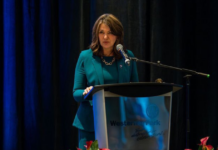Alberta Premier Danielle Smith unveiled a new budget approach to secure the province’s prosperity “long after our last barrel of oil has been produced.”
Smith told Albertans in a televised address Wednesday night how the province intends to manage its budget and finances in the years ahead.
The volatile price of oil and gas causes Albertans to ride a budgetary roller coaster from year to year, said Smith. She added that predicting world oil and gas prices is like predicting the weather during the spring in Alberta.
“It is time for our province to implement a long-term strategic financial plan that gets us to a stable, balanced budget each and every year with predictable and stable revenues to fund our core social programs,” said Smith.
The dependence on revenue from non-renewable resources has become unsustainable, the premier said.
Alberta needed about $16 billion of resource royalties to balance its $70 billion provincial budget in 2023. It was a good year for resource revenues but continuing to rely on $16 billion or more to balance the budget each year is a recipe for massive debt and cuts to health and education, she said.
“Some say the answer is higher income taxes or a sales tax. I reject this,” said Smith.
According to the premier, increasing these kinds of taxes will result in economic decline, as seen in other provinces and many states across the border.
The personal income tax cuts promised in the UCP’s 2023 election campaign will be pushed back a year to be phased in responsibly. The cuts would have created a lower income tax bracket for income below $60,000 per year, saving those earners $760 a year and a 20% reduction in their tax bill.
Former Alberta premier Peter Lougheed created the Alberta Heritage Savings Trust Fund in 1976. The fund was initially created to invest a portion of Alberta’s non-renewable resource revenues each year, so the investment income earned on the fund would eventually grow large enough to eliminate the province’s reliance on resource revenues altogether.
“In Alberta, if we had just reinvested the income earned in our Heritage Fund from the Lougheed government’s initial deposits of about $12 billion in the late 70s and early 80s, even without investing another extra dollar, our Heritage Fund would be worth over $250 billion today, earning between $12 and $25 billion per year in revenue,” said Smith.
Several countries, such as Norway, have adopted the same strategy and possess sovereign wealth funds large enough to eliminate their nation’s reliance on resource revenues entirely.
Following the Lougheed government’s initial deposit, 30% of each year’s resource revenues were invested annually. Stopping in 1987, no further deposits were made for approximately two decades. Deposits resumed briefly between 2006 and 2008, only to cease once again.
Between 1977 and 2011, the Heritage Fund’s net income was $31.3 billion. During the same period, the government withdrew $29.6 billion, according to the Fraser Institute.
By the end of 2012, the Heritage Fund’s market value was $18.4 billion. The fund was worth $21.2 billion as of March 31, 2023.
Comparatively, Alaska created the Alaska Permanent Fund in 1978. By 2014, this fund was worth $61.3 billion Canadian. The Alaskan fund invested 25% of oil revenues each year, and the government was not permitted to touch the fund principal. In 1980, Alaska updated its fund to require that 50% of all newer mineral lease rentals, royalties, royalty sale proceeds, and net profit shares be deposited.
Last year, Alberta passed a law mandating that all income earned in the Alberta Heritage Fund must be invested in the fund.
Smith has also instructed Alberta’s finance minister to limit government spending to below the legislated rate cap of inflation plus population growth.
“Instead of spending all that non-renewable surplus cash on the wants of today, we will be fiscally disciplined, invest in the Heritage Fund annually, strategically pay down maturing debt, and slowly but surely wean our province’s budget off the volatile roller coaster of resource revenues,” said Smith.
“Our province has one last shot at getting this right.”
By the end of 2024, Alberta will release a long-term financial plan to grow the Heritage Fund to between $250 and $400 billion by 2050, the same year the province plans to achieve carbon neutrality.
“Meeting these two goals simultaneously with Alberta technology, determination, and ingenuity will leave an invaluable legacy for further generations of Albertans and Canadians,” said Smith.





















